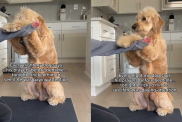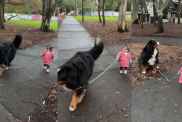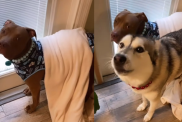Right from the outset, teach your puppy the notion of following you around the house and garden and in other fenced or safe areas. The principle of following is simple in theory; the owner leads, and the puppy follows. However, in practice the ‘following’ exercise is a little more involved and extremely amusing to watch. During the first session, owners quickly realize that training is a two-way street. Furthermore, the owner-training skills of most puppies far exceed the puppy-training ‘skills’ of most owners. Characteristically, puppies demonstrate leadership, independence and improvisation, whereas the owners follow, wait, stand, stay and eventually try to catch up with the pup by pirouetting and walking backwards in circles.
The knack of getting your puppy to pay attention and follow is really quite simple. After giving a suitable command such as “Rover, Come Along,” you should move away from your dog. Do not doddle around waiting for your dog to mobilize. Just Go! Motor! Boogie! The dog cannot follow you, if you don’t go anywhere. If you hang around, aimlessly dithering and doodling, like a lettuce trying to take root, the pup will quickly get bored and wander off. Instead, walk fast and try to lose the pup, and you will find that it will stick to you like glue.
Whatever the pup’s improvisations, alert your pup to its errant itinerary – “ROVER!!! Come Along,” and quickly do the opposite. Do not change your intended direction to try to cover up for your pup’s mistakes, or else it will never learn. Instead, accentuate the pup’s mistakes a) if your pup slows down, ‘give it some Welly’ and sprint ahead, b) if your pup runs ahead, slow down, stop dead or turn around and walk quickly in the opposite direction, c) if your pup drifts left, turn right and accelerate and d) if your pup drifts right, turn left and speed up. Your puppy will soon learn to follow the leader, if you lead. After just a minute of active following, let the pup wander off and do its own thing for a while. Then, practice a little more following, then allow the pup to lead again and so forth.
A young pup will naturally follow its owner, as if there is an invisible social bungey-cord connecting person and pup. However, as the pup matures and becomes more confident, it has less need to remain close to its owner and will be more interested in investigating its surroundings. In a sense, you will be competing with the environment for your pup’s attention. Practicing following in a setting which is unfamiliar to your pup (an enclosed tennis court or a friend’s backyard) may revive your pup’s inclination to stay close. You must train your pup to follow you by the time it is four and a half months old. The social bungey-cord breaks at five months of age, and after that, your adolescent dog’s training skills, such as they are, take over.
Your young pup’s off-leash attention can be substantially improved, if you run off and hide whenever your pup gets too far ahead or becomes overly preoccupied in some good sniffs. On realizing the owner is gone, most pups start to search frantically. Making strange noises in hiding increases the pup’s desire to find the owner, and it helps a less confident pup locate the hiding place. Always keep a close eye on the pup, and call it should it wander too far in the wrong direction. Most pups soon learn to play the game of hide ‘n seek and find their owners with little difficulty. Make sure to squeal with delight and praise the pup during the happy reunion. Other pups just have not got a clue. If you feel the pup has become too anxious, pop out from hiding and happily call the critter. With this fun game, puppies quickly develop the notion of keeping one eye or one ear on their owner at all times. It’s as if the puppy learns that it can not afford to take its eyes off its silly owner even for a second without the owner becoming lost and making weird noises.
Remember, play this game as early as possible around your house and garden. And certainly play this game in other safe outdoor areas before your puppy is four and a half months old. Unless previously trained to follow, after reaching adolescence, many dogs just do not care a wit whether their owners are in sight or on the moon.
Excerpted from How to Teach a New Dog Old Tricks, by Ian Dunbar.
Ian Dunbar is a veterinarian and animal behaviorist, founder of the Association of Pet Dog Trainers, and the author and star of numerous books and videos on dog behavior and training. He lives in Berkeley, California with his wife, trainer Kelly Dunbar, and their three dogs. The Dunbars are contributing editors to DogTime.









